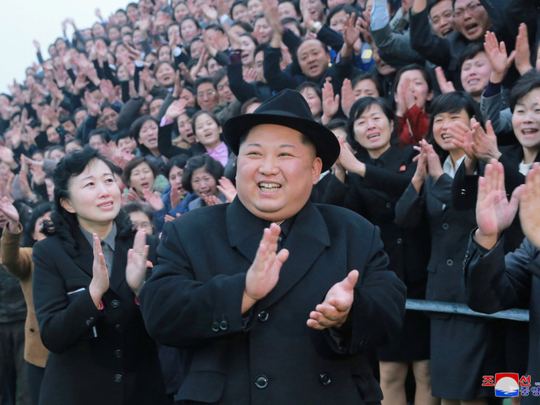
Recently, residents of Hawaii received a terrifying emergency alert on their phones: A ballistic missile was incoming. “Seek immediate shelter,” the alert warned in all-caps. “This is not a drill.” But it also wasn’t real. It was a false alarm, triggered accidentally by a state employee.
While authorities took more than half an hour to address the message, the panic it sowed was immeasurable, reviving the terror sparked by similar false alerts during the Cold War. It also reinforced the reality of the present day: Given the state of tensions with North Korea and the rogue regime’s demonstrated weapons capabilities, the prospect of ballistic missiles raining down on Hawaii can’t be shrugged off. This year, William J. Perry, a secretary of defence during the Bill Clinton administration in the United States and a dogged campaigner on the threat of nuclear weapons, declared on Twitter that “we are at greater risk of nuclear catastrophe now than we were during the Cold War”.
Here was a misunderstanding with potentially disastrous consequences. Tulsi Gabbard, a Democratic Congresswoman from Hawaii, who has emerged as an anti-hawkish, albeit controversial, voice in Washington, tweeted a plea for negotiations with Pyongyang.
But diplomacy without preconditions is certainly not the mantra of the White House. At an international summit held in the Canadian city of Vancouver, US Secretary of State Rex Tillerson pushed for greater economic pressure on the pariah regime of Kim Jong-un. “We must increase the costs of the regime’s behaviour to the point that North Korea comes to the table for credible negotiations,” said Tillerson, discussing ways to tighten sanctions against North Korea.
The meeting where he delivered those remarks could itself be seen as a somewhat confrontational act. Co-hosted by Tillerson and Canadian foreign minister Chrystia Freeland, it brought together 18 other nations, including countries as diverse as South Korea, Belgium, Colombia, Greece, India, Italy, New Zealand and Britain. Intensifying the Cold War paradigm was the absence of two other key interlocutors: China and Russia. Ahead of the Vancouver summit, officials both in Beijing and Moscow voiced their disapproval of the whole thing.
In North Korea, Cold War paranoia is all the more real. Kim’s regime feeds off a sense of permanent antipathy towards the US, which presided over a hideous bombing campaign against North Korea that lives long in the state’s memory.
“The bombing was long, leisurely and merciless, even by the assessment of America’s own leaders,” wrote former Washington Post reporter Blaine Harden a few years ago. “Over a period of three years or so, we killed off — what — 20 per cent of the population,” Air Force Gen. Curtis LeMay, head of the Strategic Air Command during the Korean War, told the Office of Air Force History in 1984. Dean Rusk, a supporter of the war and later secretary of state, said the US bombed “everything that moved in North Korea, every brick standing on top of another”.
Current tensions have only exacerbated Pyongyang’s ever-present fears — and bellicose propaganda efforts. As the summit took place, the regime chose to launch another rhetorical blast at US President Donald Trump, mocking him for his tweet about possessing a bigger “nuclear button” than Kim. “Trump’s bluff is ... just a spasm of a lunatic frightened by the might” of North Korea “and a bark of a rabid dog,” stated the commentary in Rodong Sinmun, the ruling party’s official newspaper.
Likewise, the Trump administration seems in no mood to back down. In Vancouver, Tillerson also said that the US would not stop joint military exercises with South Korea in exchange for North Korea halting its nuclear weapons programme. Known in diplomatic parlance as “freeze for freeze”, it’s a path towards de-escalation long favoured by Moscow and Beijing, but staunchly opposed by the US and its regional allies.
But essentially nothing tangible can be achieved on North Korea without buy-in from the Russians and Chinese. And so the Trump administration’s attempts at reckoning with Pyongyang will rumble fitfully on. A host of American experts on both sides of the political divide believe the Trump administration simply has to learn how to live with a nuclear North Korea.
John Delury, an expert on Chinese and regional affairs based in Seoul, argues that Washington must move beyond the Cold War paradigm for good. “A breakthrough with the United States would allow North Korea to begin normalising economic relationships with its neighbours, building on a transformation that is already quietly underway ... Over the long run, a gradual process of dismantlement could lead to denuclearisation as the sense of mutual threat is eliminated,” Delury wrote in Foreign Policy. “If Mao, who talked of nuclear war as a real possibility that China could survive, and Nixon, who built his career on fighting Communism, could bury the sword in the interests of geopolitical stability, why can’t Kim and Trump? They can. And they must.”
— Washington Post
Ishaan Tharoor writes about foreign affairs. He previously was a senior editor and correspondent at Time magazine, based first in Hong Kong and later in New York.












